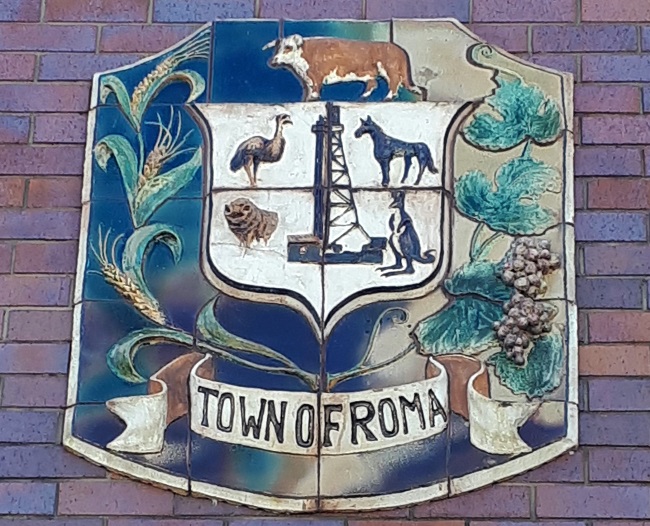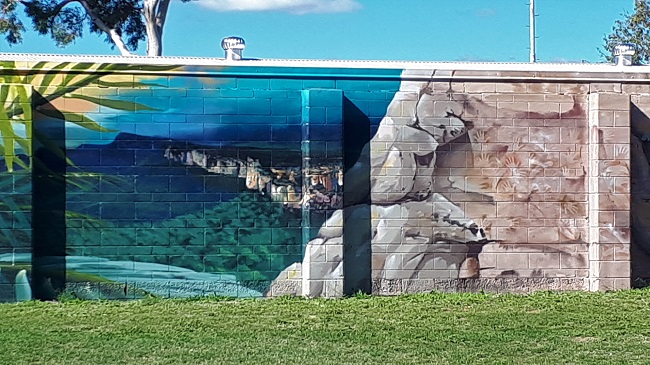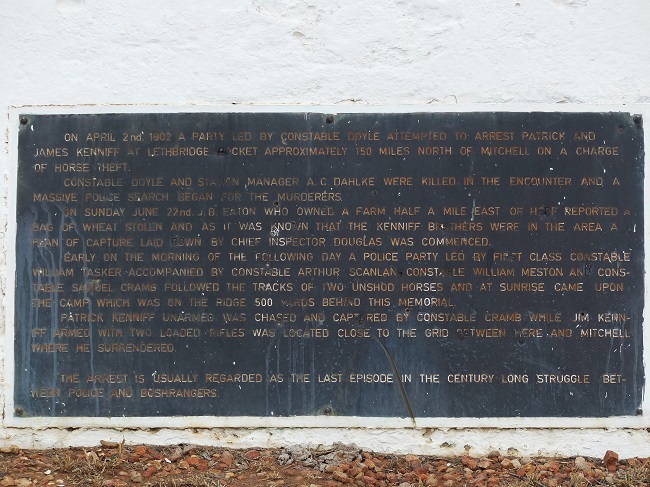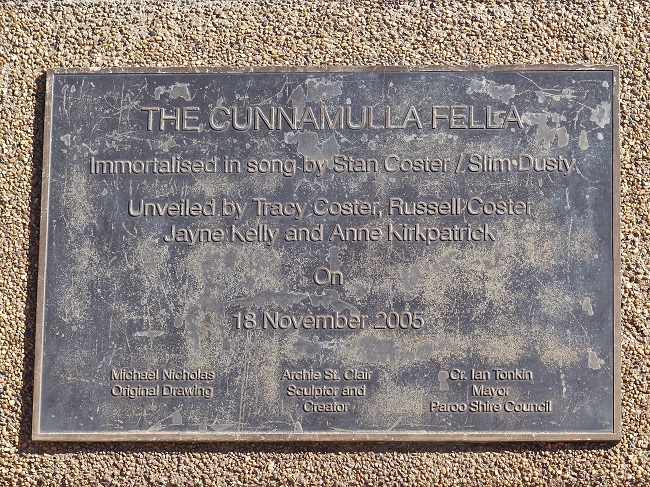Western Queensland Road Trip #15
Street art tells a story, and every outback town has a story to tell.
A mosaic shield on the Maranoa Regional Council building in Roma depicts the region’s rich history of agriculture and natural gas production.

Inside the building a much larger mosaic shows more detail: vineyards and wineries, gas fields, sheep and cattle farming, the road and rail routes which opened up the outback. Indigenous first peoples and industrious pioneers are featured along with those beautiful bottle trees Roma is famous for.

There’s no mistaking the purpose of these parking bays at the Roma Community Art Centre.

The wall around Roma’s Bassett Park has been transformed into a giant canvas. A mural 100 metres long details a day in the life of the Maranoa Region, from sunrise to sunset. Aboriginal art, local native plants and a rig on the oil and gas fields all feature on the panels. Most spectacular is the image of Carnarvon Gorge, with its rugged sandstone cliffs disappearing into the distance.





Just south of Mitchell, a cluster of dramatic red figures stands beside of the highway. The memorial pays homage to the local constabulary who, in the early 20th century, protected the district from the Kenniff brothers, the last of Australia’s notorious bushrangers. A nearby plaque tells the story of the crimes and final demise of the brothers.



On Wills Street in Charleville, Matilda the big kangaroo greets visitors with a friendly wave. With her bush hat on, a swag on her back and a joey in her pouch, she’s ready to hop away on a new adventure. Further down the street, a giant yellow belly encourages anglers to throw in a line at the Warrego River.
Outside the Paroo Shire Hall in Cunnamulla, an Australian bushman sits on his swag, savouring a mug of billy tea. Titled “The Cunnamulla Fella” the statue depicts the iconic Australian character described in the song of the same name, written by Stan Coster and recorded by Slim Dusty.


Just across the road are more well-known Australians.

The beautiful painted silos at Thallon are easily seen from the highway but it’s worth driving right into town for a closer view.


There’s no need to get up close to see this Northern Hairy Nosed Wombat. Located in the park in the centre of Thallon, the oversized sculpture brings attention to the wombat’s critically endangered status. Once found right across eastern Australia, this species of wombat now survives in just two areas of Queensland; in a National Park near Clermont and a conservation park near Thallon. At the Richard Underwood Nature Refuge, more than 200 wombats live in a securely fenced colony, protected from predators like wild dogs.

Flora and fauna, history and heritage, people and places – street art tells the stories of the towns of the outback.


There’s some wonderful art on display in this post – the region must be a joy to visit! Wombats are my favourite Australian creature!
LikeLiked by 2 people
There’s so much to offer in these small regional towns Pauline. We were surprised at the range of activities. Wombats are very cute.
LikeLiked by 1 person
I love the Thallon wombat!
LikeLiked by 1 person
Isn’t he great. I’m glad the real ones aren’t that large.
LikeLike
I love the artwork on Silos. A brilliant way to get more folk to visit the small towns in the Outback. We have always enjoying tripping around the Outback, though the long drives can get a bit much, much easier if time is not an issue.
LikeLiked by 1 person
We did short trips from one town to the next on this adventure so the distances weren’t so great. We like seeing painted silos and water towers too. The work is so clever.
LikeLike
It is very clever.
LikeLiked by 1 person
wow so much in one little place
LikeLiked by 1 person
Hi Becky. These pieces were in several towns, over a distance of several hundred kilometres. So not as little as you might imagine. 🙂
LikeLike
Ah that makes more sense!
LikeLike
That was a real education.
I wonder, what caused the wombat numbers to fall so badly? Were they hunted?
LikeLiked by 1 person
No, I don’t believe they were hunted. It was loss of habitat and too many predators.
LikeLiked by 1 person
👍 do those whistle when the wind blows ❓ thanks for sharing these 🙂
LikeLiked by 1 person
Quite possibly, although it wasn’t windy when we were there.
LikeLiked by 1 person
Brilliant street art of many different types, I love the wombat (I’ve always wanted one of those, I think they are so cute) but my favourites have to be the painted silos and the long mural, they are fabulous 🙂
LikeLiked by 1 person
The painted silos are spectacular, especially when they first appear in the distance. Thanks, Eunice.
LikeLike
Hello.
Post to my mind. Art is art and I love them. Other photos were interesting also and it was a great joy to see them. Thank you.
Have a good day!
LikeLiked by 1 person
Thank you Matti. I’m so pleased you enjoyed seeing these different artworks.
LikeLiked by 1 person
So beautiful
LikeLiked by 1 person
And all very different too. 🙂
LikeLike
Yes they are.
LikeLike
Wonderful share, Carol. The wombat has quite an endearing face. 😍
LikeLiked by 1 person
Just like they do in real life. They are very cute creatures.
LikeLiked by 1 person
A fabulous variety! My favourites are the long mural and the inside mosaic at Roma.
LikeLiked by 1 person
Anabel, the mosaic was accompanied by an audio recording which described each part. It was so interesting.
LikeLike
Even better!
LikeLiked by 1 person
Love those flowers on the blue wall, Carol, and the cliffs. Some lovely stuff there 🙂 🙂
LikeLiked by 1 person
The cliffs are just a small part of Carnarvon Gorge Jo, and they’re depicted beautifully. We’re hoping to visit soon. I haven’t been there since I was little.
LikeLike
It looks wonderful. Far from you? :)) 🙂
LikeLiked by 1 person
Not far – only 600 km!! Easily done in a day if we wanted to. We can’t yet, as day trips are limited to 50 km maximum from home but that will change in the next few weeks.
LikeLike
Lots of variety there, all terrific.
LikeLiked by 1 person
And so much fun spotting them all.
LikeLike
That wall and those silos are astonishingly beautiful. I love that there are so many sculptures and quirky outdoor art in Australia, along with all the BIG advertising objects like that rather weird looking kangaroo and the fish!
LikeLiked by 1 person
Street art has become really popular in the last few years and some of it is really beautiful.
LikeLike
You know how to enjoy your surroundings. I love the murals, but I must say the bike racks brought a smile and an attaboy for the designer.
LikeLiked by 1 person
They are so cute and clever aren’t they.
LikeLike
Love the huge murals and sculptures!
LikeLiked by 1 person
We did too. They say so much about each district. Thanks Denzil.
LikeLiked by 1 person
Such wonderful street art, makes travelling around so interesting doesn’t it? Really the cunnamulla fella as there is a real story behind him but they are all great.
LikeLiked by 1 person
Most of them came from true stories but that Cunnamulla Fella is about as real as they come. We know people exactly like that.
LikeLiked by 1 person
Love the mosaics and street art, especially on the Silos. Here in Brisbane, they tend to bulldoze silos down, which is such a shame.
I’ve nominated you for the Liebster Award and hope you’ll join in…no pressure though and a bit of fun. 😉
https://imageearthtravel.com/2020/05/10/liebster-award-nomination-4/
LikeLiked by 1 person
Thanks. We actually have quite a lot of street art in Toowoomba on the sides of buildings. It’s lovely.
LikeLiked by 1 person
I’m yet to visit Toowoomba.
LikeLike
Come in September for the Carnival of Flowers when all the gardens are blooming.
LikeLiked by 1 person
I’d love to as have heard all about the flowers…need to see if lockdown is over by then though. 😉
LikeLike
Surely by then we’ll be on the road again.
LikeLiked by 1 person
Hope so but for now, I have a lot of writing to do so keeping super busy.
LikeLike
Great murals. I especially like the ones painted on the silos. Thanks for sharing.
LikeLiked by 1 person
The silos were stunning and almost glowed.
LikeLiked by 1 person
We’re such an artistic country aren’t we. Those murals and street art are popping up everywhere. It’s wonderful!
LikeLiked by 1 person
It’s definitely become a popular thing in the last few years. I love how a huge painting gives character to a building or silo.
LikeLiked by 1 person
Absolutely! And transforms a whole tiny community.
LikeLiked by 1 person
Such beautiful photographs, sentiments and an eclectic collection of
Aussie icons. Thanks for sharing and making my day!
LikeLiked by 1 person
Thank you! That’s a lovely compliment. Glad you enjoyed this post Merryn.
LikeLike
Wonderful to see the street art of Roma, Italy is replicated in Roma, Australia!
LikeLiked by 1 person
Lol, true! Although the subject matter is quite different. 🙂
LikeLike
Wonderful murals and sculptures! This made my day!
LikeLiked by 1 person
Hi Leif. I’m so glad you enjoyed this post. 🙂
LikeLike
Very nice article that you wrote.
I really enjoyed the photo’s that you took. Really interesting art.
LikeLiked by 1 person
It’s amazing what people can do with a wall and some paint. 🙂
LikeLike
all very interesting to view and watch
LikeLike
Thank you. There are so many talented people everywhere.
LikeLike